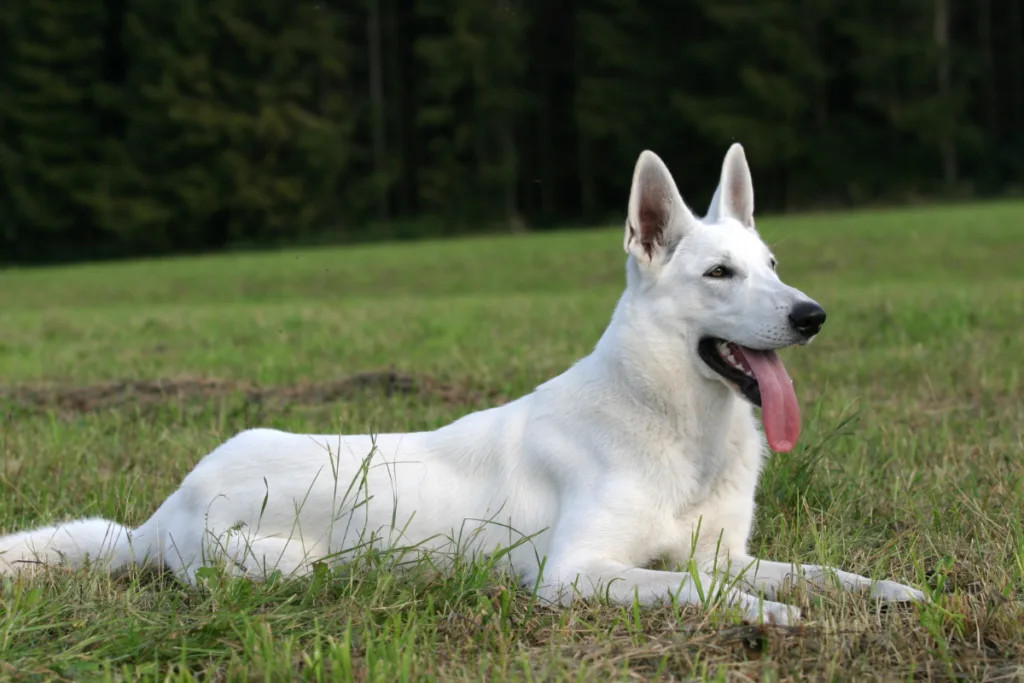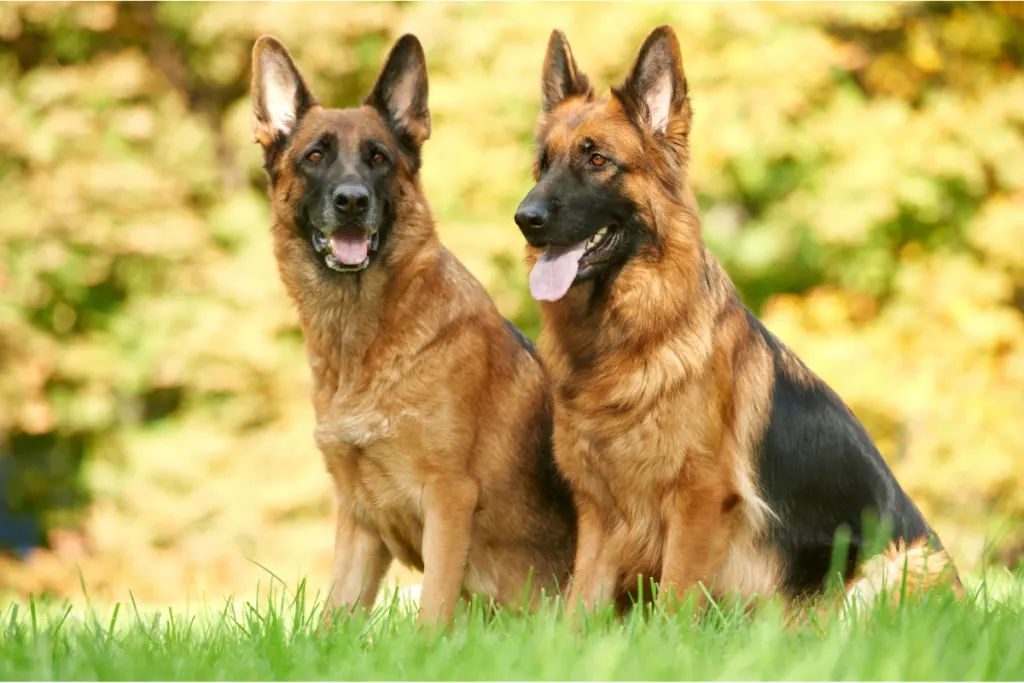
Understanding your German Shepherd’s physical and emotional development is an important part of dog ownership, and it is vital that you are aware of certain growth and development milestones throughout your GSD’s life.
By doing so, you can watch for any signs of trouble and ensure that your pup is well on its way to becoming a healthy adult.
Throughout their development, puppies need to reach certain milestones, including weight and height goals, just like human babies.
Without knowing what to expect, a German Shepherd’s growth may be a bit puzzling and lead you to make improper decisions about their nutrition, exercise, or socialization.
Consider the following example of fact:
When a German Shepherd reaches a weight of 70 lbs and a height of 23”, you may think that it is no longer a puppy. However, German Shepherds can reach these measurements when they are only 9 months old, but they do not reach adulthood until they are 18 months to 3 years old.
This article will help guide you through what to expect from your male or female German Shepherd as they grow from young pups to adulthood, beginning with an overview and then breaking it down into the specifics.
Birth – 3 Years Old Overview of Average GSD Weight and Height
| Age (months) | Average Weight (lbs) | Height Range (inches) | ||
| Male | Female | Male | Female | |
| Birth | 1.1 | 1.1 | N/A | N/A |
| 1 | 7.5 | 7 | 4 – 6 | 3 – 6 |
| 2 | 15.5 | 14.5 | 7 – 9 | 6 – 9 |
| 3 | 26.5 | 22.5 | 9 – 11 | 8 – 10 |
| 4 | 37.5 | 33.5 | 11 – 14 | 10 – 12 |
| 5 | 46.5 | 40 | 14 – 16 | 12 – 14 |
| 6 | 53 | 46.5 | 16 – 18 | 15 – 17 |
| 7 | 60 | 51 | 19 – 20 | 17 – 19 |
| 8 | 64 | 55.5 | 20 – 22 | 18 – 20 |
| 9 | 68 | 57.5 | 21 – 23 | 19 – 21 |
| 10 | 70.5 | 60 | 22 – 24 | 19 – 21 |
| 11 | 72.5 | 62 | 22 – 24 | 20 – 22 |
| 12 | 75 | 62 | 22 – 24 | 20 – 22 |
| 18 | 79.5 | 62 | 23 – 25 | 21 – 22 |
| 24 | 82 | 64 | 23 – 25 | 21 – 22 |
| 36 | 84 | 66.5 | 24 – 26 | 22 – 24 |
German Shepherds are a large breed of dog, and it is important to monitor their weight and growth in order to ensure that they are reaching their milestones.
It is also important to note that males and females have different weight and growth ranges in the different developmental stages.

Additionally, you must ensure that your German Shepherd is neither underweight nor overweight, as these conditions can impact their growth and health.
German Shepherd Weight Range And Growth (Height Range) Chart
Below you will find a chart that breaks down the overview above into more specific heights and weights, also including growth as a percentage to indicate how far along your German Shepherd is towards becoming a full grown adult.
This chart is a guideline, and as long as your GSD reaches the goals set forth in it, it doesn’t matter if they are reached a bit sooner or a bit later as long as they are healthy during the process.
If you are concerned that your dog is gaining too much weight too quickly, or its growth seems to have halted, you should take your German Shepherd to a veterinarian to be checked out.
| Age | Gender | Weight Range | Average Weight | Height Range | % Adult Weight And Height |
| Birth | Both | 0.8 – 1.3 lbs | 1.1 lbs | N/A | N/A |
| 1 week | Both | 1.6 – 2.1 lbs | 1.8 lbs | N/A | N/A |
| 1 month | Male | 5.5 – 9 lbs | 7.5 lbs | 4 – 6” | 10 |
| Female | 4.5 – 8 lbs | 7 lbs | 3 – 6” | ||
| 2 months | Male | 16 – 20 lbs | 15.5 lbs | 7 – 9” | 22 |
| Female | 11 – 17 lbs | 14.5 lbs | 6 – 9” | ||
| 3 months | Male | 22 – 30 lbs | 26.5 lbs | 9 – 11” | 40 |
| Female | 17 – 26 lbs | 22.5 lbs | 8 – 10” | ||
| 4 months | Male | 35 – 40 lbs | 37.5 lbs | 11 – 14” | 50 |
| Female | 31 – 35 lbs | 33.5 lbs | 10 – 12” | ||
| 5 months | Male | 40 – 49 lbs | 46.5 lbs | 14 – 16” | 60 |
| Female | 35 – 44 lbs | 40 lbs | 12 – 14” | ||
| 6 months | Male | 49 – 57 lbs | 53 lbs | 16 – 18” | 70 |
| Female | 44 – 49 lbs | 46.5 lbs | 15 – 17” | ||
| 7 months | Male | 57 – 62 lbs | 60 lbs | 19 – 20” | 80 |
| Female | 49 – 53 lbs | 51 lbs | 17 – 19” | ||
| 8 months | Male | 62 – 66 lbs | 64 lbs | 20 – 22” | 85 |
| Female | 53 – 57 lbs | 55.5 lbs | 18 – 20” | ||
| 9 months | Male | 64 – 71 lbs | 68 lbs | 21 – 23” | 90 |
| Female | 55 – 60 lbs | 57.5 lbs | 19 – 21” | ||
| 10 months | Male | 66 – 73 lbs | 70.5 lbs | 22 – 24” | 92 |
| Female | 57 – 62 lbs | 60 lbs | 19 – 21” | ||
| 11 months | Male | 66 – 75 lbs | 72.5 lbs | 22 – 24” | 95 |
| Female | 60 – 64 lbs | 62 lbs | 20 – 22” | ||
| 12 months | Male | 71 – 75 lbs | 75 lbs | 22 – 24” | 95 |
| Female | 60 – 64 lbs | 62 lbs | 20 – 22” | ||
| 18 months | Male | 71 – 79 lbs | 79.5 lbs | 23 – 25” | 98 |
| Female | 60 – 66 lbs | 62 lbs | 21 – 23” | ||
| 2 years | Male | 71 – 84 lbs | 82 lbs | 23 – 25” | 98 |
| Female | 62 – 66 lbs | 64 lbs | 21 – 22” | ||
| 3 years | Male | 79 – 88 lbs | 84 lbs | 24 – 26” | 100 |
| Female | 66 – 70 lbs | 66.6 lbs | 22 – 24” |
0 – 2 Weeks: The Neonatal Period Of German Shepherd Development

Neonatal Weights
At birth, German Shepherd puppies usually weigh 0.8-1.3 lbs (370-600 g).
Birth weight depends on a number of factors, including the size of the mother and the size of the litter (4-9 puppies).
Over the first week, German Shepherd puppies will grow quickly. During this first week, they can approximately double their birth weight to 1.6-2.1 lbs (726-953 g).
The amount of weight gain at this time can vary, but as long as it is increasing every day, then there should be no cause for concern.
Other Neonatal Physical And Behavioral Developments
When your German Shepherd puppy is born, it is not as well developed as a human baby.
Puppies are only in the womb for about nine weeks, and at birth, their brains are not fully developed, and their eyelids and ear canals are sealed to protect the still-developing structures of sight and hearing.
German Shepherd puppies are extremely helpless in the neonatal stage.
They are toothless and unable to regulate their body temperature.
They even require help to urinate and excrete fecal matter.
Puppies rely heavily on their sense of smell to locate their mother, who devotedly provides all they need: milk, warmth, and comfort.
German Shepherd mothers even have to stimulate urination and excretion by licking their puppies’ bottoms.
Over the first week, the puppies will begin to crawl, and 10-14 days after birth, German Shepherd puppies’ eyes and ears open.
2 – 4 Weeks: The Transitional Period Of German Shepherd Development

Transitional Period Weights And Heights
A German Shepherd puppy’s weight should continue to increase during the transitional period.
At this stage, the puppies’ weight and size will start to show signs of sexual dimorphism, which essentially means the difference between males and females.
- At the age of 1 month, male German Shepherds will weigh 5.5-9 lbs (2.5-4 kg) and be 4-6” (11-16 cm) in height.
- Females at the same age will weigh 4.5-8 lbs (2-3.5 kg) and be 3-6” (8-14 cm) in height.
Other Transitional Period Physical And Behavioral Developments
During the transitional period of German Shepherd development, their teeth will start to erupt, and puppies will become efficient crawlers and even start to walk and explore their surroundings.
They also become more independent and are able to urinate and excrete without assistance.
At around 4 weeks, your German Shepherd puppy will change from grunting to barking and growling.
Related: Why Do German Shepherds Bark? All You Need to Know
4 – 12 Weeks: The Socialization Period Of German Shepherd Development

Socialization Period Weights And Heights
At 4 weeks, German Shepherd puppies have typically reached 10% of their adult weight and height; by 8 weeks, they are at 22%; and by the end of the socialization period, they are typically at 40% of their adult weight and height!
| Age | Gender | Weight Range (lbs) | Weight Range (kg) | Height Range (inches) | Height Range (cm) |
| 1 month | Male | 5.5 – 9 | 2.5 – 4 | 4 – 6” | 11 – 16 |
| Female | 4.5 – 8 | 2 – 3.5 | 3 – 6” | 8 – 14 | |
| 2 months | Male | 16 – 20 | 6 – 9 | 7 – 9” | 17 – 22 |
| Female | 11 – 17 | 5 – 7.5 | 6 – 9” | 14 – 22 | |
| 3 months | Male | 22 – 30 | 10 – 14 | 9 – 11” | 23 – 27 |
| Female | 17 – 26 | 8 – 12 | 8 – 10” | 20 – 25 |
Other Socialization Period Physical And Behavioral Developments
This is a crucial period for German Shepherd puppies.
Their history as herders means that they are not naturally very sociable dogs and can develop behavioral issues if not taught how to interact with humans, other dogs, and other pets.
Related: How To Socialize Your German Shepherd
During the socialization period, German Shepherd puppies should stay with their mothers and littermates to learn dog manners and social cues.
You can start to supplement their milk diet with soft foods, but don’t change them over completely.
This supplementation is also helpful for the mothers because the German Shepherd puppies now have all of their needle-sharp teeth!

You can start house-breaking a German Shepherd puppy at around 7 weeks of age, but don’t expect them to master it immediately; they are still very young.
You can also start some basic training at 9-12 weeks.
In the middle of the socialization period, around 6-9 weeks of age, German Shepherd puppies go through a fearful stage.
You should help them overcome this through positive reinforcement and encouragement.
This stage is perfectly normal for dogs, so do not worry, but be patient with them.
Another great milestone towards the end of the socialization period is that your German Shepherd’s ears should start to stand up.
Related: When Will My German Shepherd’s Ears Stand up?
3 – 6 Months: The Juvenile Period Of German Shepherd Development

Juvenile Period Weights And Heights
At the start of the or juvenile. or ranking, period male and female German Shepherd puppies weigh 40% of their adult weight and are at 40% of their adult height.
The juvenile period is also called the “ranking” period, because this is when puppies begin to understand submission and dominance.
By the end of the ranking period, they have reached 70% of their adult weight and height measurements.
| Age | Gender | Weight Range (lbs) | Weight Range (kg) | Height Range (inches) | Height Range (cm) |
| 3 months | Male | 22 – 30 | 10 – 14 | 9 – 11 | 23 – 27 |
| Female | 17 – 26 | 8 – 12 | 8 – 10 | 20 – 25 | |
| 4 months | Male | 35 – 40 | 16 – 18 | 11 – 14 | 29 – 35 |
| Female | 31 – 35 | 14 – 16 | 10 – 12 | 26 – 31 | |
| 5 months | Male | 40 – 49 | 18 – 22 | 14 – 16 | 35 – 40 |
| Female | 35 – 44 | 16 – 20 | 12 – 14 | 31 – 36 | |
| 6 months | Male | 49 – 57 | 22 – 26 | 16 – 18 | 41 – 46 |
| Female | 44 – 49 | 20 – 22 | 15 – 17 | 37 – 42 |
Other Juvenile Period Physical And Behavioral Developments
During the juvenile or ranking period, German Shepherd puppies start to understand and learn about dominance and submission within a pack.
They can begin proper obedience training towards the end of this period, but you need to bear in mind that your puppy’s attention span is still quite short.
At around 4 months, they also go through a chewing phase as they start to lose their baby teeth, and they can enter another fear phase.
By the end of the ranking period (6 months), a German Shepherd puppy’s ears should be standing up completely, and they should have all of their adult teeth.
6 – 18 Months: The Adolescent Period Of German Shepherd Development

Adolescent Period Weights And Heights
When male and female German Shepherd puppies enter the adolescent period of their development, they are at 70% of their adult weight and height.
By the end of this period (1.5 years of age), male and female German Shepherds are at 98% of their adult weight and height.
They hit 90% at 9 months, and then growth slows down.
| Age | Gender | Weight Range (lbs) | Weight Range (kgs) | Height Range (inches) | Height Range (cm) |
| 6 months | Male | 49 – 57 | 22 – 26 | 16 – 18 | 41 – 46 |
| Female | 44 – 49 | 20 – 22 | 15 – 17 | 37 – 42 | |
| 7 months | Male | 57 – 62 | 26 – 28 | 19 – 20 | 47 – 52 |
| Female | 49 – 53 | 22 – 24 | 17 – 19 | 43 – 48 | |
| 8 months | Male | 62 – 66 | 28 – 30 | 20 – 22 | 51 – 56 |
| Female | 53 – 57 | 24 – 26 | 18 – 20 | 45 – 50 | |
| 9 months | Male | 64 – 71 | 29 – 32 | 21 – 23 | 54 – 59 |
| Female | 55 – 60 | 25 – 27 | 19 – 21 | 48 – 53 | |
| 10 months | Male | 66 – 73 | 30 – 33 | 22 – 24 | 55 – 60 |
| Female | 57 – 62 | 26 – 28 | 19 – 21 | 49 – 54 | |
| 11 months | Male | 66 – 75 | 30 – 34 | 22 – 24 | 57 – 62 |
| Female | 60 – 64 | 27 – 29 | 20 – 22 | 51 – 56 | |
| 12 months | Male | 71 – 75 | 32 – 34 | 22 – 24 | 57 – 62 |
| Female | 60 – 64 | 27 – 29 | 20 – 22 | 51 – 56 | |
| 18 months | Male | 71 – 79 | 32 – 36 | 23 – 25 | 59 – 64 |
| Female | 60 – 66 | 27 – 30 | 21 – 23 | 53 – 57 |
Other Adolescent Period Physical And Behavioral Developments
During the adolescent period of German Shepherd development, you can expect your dog to challenge you more as they find their place in the pack and settle into their role.
It is important at this stage that you reinforce your position as the pack leader or alpha.
They will also try to move up the ranks in your dog pack, so if you have more than one dog, your pack may temporarily destabilize, with more fighting and disagreements among your dogs.
This is normal, but you will need to be careful and watchful to ensure that nothing gets out of control.
As adolescents, German Shepherds also start displaying sexual behavior if they are unsterilized.

Females can go into heat from 6 months old.
Males will begin cocking their legs while urinating and can start to mark around your property.
You will need to stop marking behavior if they start trying to do this in the house.
Related: Should You Spay or Neuter a German Shepherd?
You need to watch out for your shoes and furniture because German Shepherds can enter a second chewing phase at 7-9 months old.
If you have not already started obedience training, it is important that you begin in earnest during this period.
German Shepherds are large, active, and protective dogs; it is important that you have rules in place and that they know what and when you are asking something of them.
However, obedience training doesn’t just help you; it provides beneficial mental and physical stimulation for your German Shepherd and allows them to bond with you.
Related: German Shepherd Training Guide: All You Need to Know
18 Months And Onward: Adulthood In German Shepherds

Although some female German Shepherds can reach full adulthood by 16 months, most only reach it by 18 months to 2 years.
Male German Shepherds only reach full adulthood around the ages of 2.5-3 years.
| Age | Gender | Weight Range (lbs) | Weight Range (kgs) | Height Range (inches) | Height Range (cm) |
| 18 months | Male | 71 – 79 | 32 – 36 | 23 – 25 | 59 – 64 |
| Female | 60 – 66 | 27 – 30 | 21 – 23 | 53 – 57 | |
| 2 years | Male | 71 – 84 | 32 – 38 | 23 – 25 | 59 – 64 |
| Female | 62 – 66 | 28 – 30 | 21 – 22 | 53 – 57 | |
| 3 years | Male | 79 – 88 | 36 – 40 | 24 – 26 | 60 – 65 |
| Female | 66 – 70 | 28 – 32 | 22 – 24 | 55 – 60 |
Here is a great video of just what you can expect from a German Shepherd’s growth in terms of size as well as personality from 7 weeks to 2 years old:
Correct Proportions Of A German Shepherd
According to the German Shepherd Dog Club of America, both male and female German Shepherd dogs should have a 10:8.5 ratio of length to height.
Length is measured from the dog’s breastbone to the rear edge of its pelvis, and height is measured along the withers.
When your German Shepherd is the ideal weight, you can feel their ribs, although they are not easily seen, and they are not covered in a layer of fat.
There should be a defined waistline when your dog is viewed from above and a noticeable tummy tuck when they are viewed from the side.
Underweight German Shepherds
While German Shepherds are growing, they will be thinner and look gangly until they fill out in adulthood. It is sometimes recommended to keep your growing German Shepherd marginally underweight (but not unhealthily thin) while their joints grow and strengthen.
It’s not a matter of getting your German Shepherd to lose weight at this stage, but rather to put it on more slowly.
Speak to a veterinarian about this method of protecting your dog’s joints before attempting it.
Purina defines two levels of underweight: thin and slightly underweight.
- Thin: Ribs, hips, and spine are easily felt, and there is no fat covering the sides and back.
There is noticeable muscle loss around shoulders and thighs, an overly pronounced waistline from the top view, and an overly pronounced tummy tuck from the side view. - Slightly underweight: Ribs can be easily felt, hips and spine may be slightly visible if your German Shepherd has shorter hair, but there is no fat covering.
There is an obvious waistline from above and a marked tummy tuck from the side.
If your German Shepherd is underweight or thin, speak to your veterinarian.
It could be that they are just growing quickly, often becoming lightly underweight after a growth spurt and then putting weight on until the next growth spurt.
You may just need to change their food or feed them larger and more frequent meals.
However, their low weight may indicate parasites or another underlying medical condition.
Related: Why is my German Shepherd Puppy so Skinny?
Elderly German Shepherds can struggle with being underweight.
This is why senior dog foods typically have a higher calorie count.
Overweight German Shepherds

It is important to prevent your German Shepherd from becoming overweight while they are growing.
Extra weight on developing joints and muscles can cause problems.
German Shepherds can also suffer from hip dysplasia, which is worsened by excess weight.
Other excessive weight-related conditions include diabetes, pancreatitis, heart problems, respiratory problems, kidney disease, and arthritis.
Related: German Shepherd Joint Problems: All You Need to Know
Your German Shepherd is not likely to become overweight in the first 9 months of their lives because their growth rate easily matches their calorie intake.
When your German Shepherd reaches 9 months, growth slows down significantly, and you may need to adjust their food quantities to account for this sudden reduction in calorie requirements.
A helpful tip is to switch to low-calorie treats during this stage, especially considering training needs to intensify, and people often use treats for positive reinforcement incentives.
And instead of switching to a calorie-restricted food or reducing the amount you feed your German Shepherd, speak to a veterinarian about switching from puppy food to adult food.
Purina defines four levels of overweight: slightly overweight, markedly overweight, obese, and clinically obese.
- Slightly overweight: Ribs can be felt slightly, but there is an obvious layer of fat covering the ribcage and back.
There is a slight waistline when viewed from the top, but it is not clear.
There is a slight tummy tuck towards the hind legs when viewed from the side. - Markedly overweight: Ribs are not easily felt, and there is an obvious layer of fat over the ribcage.
There are fatty pads along the lower back and at the base of the tail, making the waistline absent when viewed from above. - Obese: Ribs are difficult to feel because of the fatty layer covering them.
There are significant fatty pads along the lower back and at the base of the tail, making the waistline absent when viewed from above.
And the tummy bulges outward and sags slightly when viewed from the side. - Clinically obese: Ribs cannot be felt under the fatty layer.
There are significant fatty pads around the neck and legs, along the lower back, and at the base of the tail.
The waistline is absent when viewed from above.
The tummy significantly bulges and sags when viewed from the side.
Related: Is My German Shepherd Overweight? Here’s How to Tell
Variations Of German Shepherds
It is worth noting that these charts do not apply to the different variations of Shepherds, except possibly White German Shepherds (they have the same average adult weight and height ranges as a German Shepherd).

East-European Shepherds, King Shepherds, and Shiloh Shepherds are bigger than standard German Shepherds.
Miniature German Shepherds are much smaller and have completely different development requirements and problems.
Final Thoughts
The weight and growth charts provided in this article are designed to provide guidelines for the developmental milestones your puppy should be reaching in the first 2-3 years of its life.
Male German Shepherds are bigger and heavier than females, and from 2-4 weeks old, these differences become apparent.
Although males and females have different weight and height targets at each stage, they should hit the same percentages of their adult weight at the same age.
A fully grown adult male German Shepherd will weigh between 79 and 88 lbs and stand 24 to 26” tall.
A fully grown adult female German Shepherd will weigh between 66 to 70 lbs and stand 22 to 24” tall.
At 1 month, a German Shepherd should be at 10% of the average adult weight and height; at 6 months, they should be at 70%; at 9 months, they should be at 90%, and they should reach full adult size by 3 years.

If your puppy is slightly above or below the average weight or height at a given age, it does not mean that there is a problem.
However, if your German Shepherd puppy starts to fall more and more behind, or if they miss other developmental milestones other than weight and height, it may indicate an underlying medical condition, and you will need to take your dog to see a veterinarian.
Deficiencies in weight can compromise growth and the general condition of your German Shepherd, and excess weight can cause joint injury and other serious medical conditions.
Keep all of these things in mind and be observant of your growing pup and how you approach feeding and training in accordance.
By doing this, you will ensure that you have a happy, healthy, and well-adjusted German Shepherd for many years to come!
